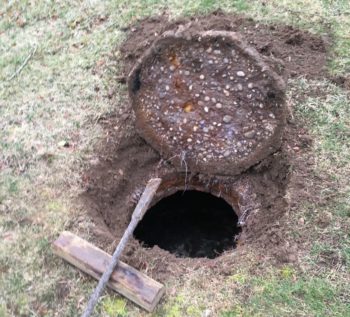Protecting & Restoring Long Island's Peconic Bays
There are many sources of water pollution to the Peconic Estuary - including wastewater, fertilizers, pesticides, stormwater runoff, atmospheric deposition, and animal waste.
Septic Systems and Wastewater>>>

Wastewater is waste discharged from sewage treatment plants and from residential on-site septic systems and cesspools. While it may not be a pretty topic, “down the drain” waste management is an important issue for East Enders. It can be easy to forget that waste doesn’t just disappear down the drain – it ends up in our backyards, groundwater, and local surface waters. With this in mind, we must be careful about what we put down our drains and also protect the ecological systems that filter this waste.
Wastewater is the largest land-based contributor of nitrogen (50%) to the Peconic Estuary. Much of the nitrogen pollution has been linked to unsewered dense suburban sprawl. An estimated 69 percent of the total nitrogen affecting our ground and surface water supplies comes from wastewater, specifically septic systems (onsite sewage disposal systems). Only twenty-six percent (26%) of the County’s residences utilize sewers as means of wastewater treatment. The remaining seventy-four percent (74%) of the residences use Onsite Wastewater Treatment Systems (OWTS), including septic systems and cesspools, to meet their sewage disposal needs. The County contains the highest density of onsite septic systems within the tri-state area with approximately 365,000 homes currently utilizing OWTS; approximately 250,000 of those systems are cesspools, predating the requirement of a septic tank (implemented in 1973). The OWTS have limited ability to reduce the amount of nitrogen in our wastewater. Therefore, when our waste flows from our homes to the septic system, most of the nitrogen in our waste ends up in the groundwater. When this happens, there is also a strong possibility that pollutants and excess nutrients are reaching our local surface waters and contributing to nutrient loading. Nutrient loading from residential septic systems and cesspools are the main reasons for hypoxia, harmful algal blooms, and habitat degradation in the Peconic Estuary. Of particular concern are the onsite septic systems located in the groundwater contributing areas of drinking water wells and estuarine surface waters.
Wastewater is the largest land-based contributor of nitrogen (50%) to the Peconic Estuary.
The only major wastewater treatment plant that contributes to the Peconic Estuary is the Riverhead Sewage Treatment Plant (STP). While this plant is not a significant source of pollution to the Estuary, it can contribute to locally significant water quality problems.
Fertilizers from agriculture, lawns, and golf courses contribute to over ¼ of the land-based nitrogen that enters the estuary. Many homeowners and commercial landscapers use nitrogen-containing fertilizer on lawns. Additionally, Suffolk County continues to be a leading agricultural producer in New York State, and the agricultural industry in Suffolk County is dependent on the use of nitrogen fertilizers and pesticides. Pesticides and the nitrogen from fertilizers can move through the soil and pollute our groundwater. These pollutants can also be transported to the Estuary via stormwater (see next section). While our individual inputs may seem small, the cumulative effect of thousands of properties in a coastal watershed can pose serious threats to the health of our bays. Eliminating or reducing turf fertilizer and pesticide applications can result in significant decrease in nitrogen and pesticide input to the estuary at effectively no cost.
Applying Fertilizer between November 1st and April 1st is prohibited in Suffolk County.
Suffolk County Fertilizer Law Information
Stormwater is water from rain and snow that moves across impermeable surfaces (roof tops, driveways, roads, parking lots and other surfaces that do not allow the water to soak into the ground). This water flows along or runs off impermeable surfaces and enters storm drain systems or directly flows over land making its way to waterbodies, such as lakes, rivers and bays. Stormwater pollution occurs as stormwater runoff flows over surfaces, collecting and transporting debris, natural and human-made pollutants into nearby waterbodies. Debris and pollutants carried by stormwater– like motor oil, fertilizers, pesticides, sediment, animal waste and garbage– can be harmful to aquatic life and create human health risks. Stormwater pollution is considered non-point source (NPS) pollution because it comes from many different sources and people– not just a single source. Because of this, stormwater pollution is harder to prevent.
Once roads became paved for automobile use, less rainwater was able to soak into the ground causing an increase in stormwater runoff. As development increases and more roads, shopping centers and homes are built, stormwater runoff becomes a more pressing issue. The more impervious surfaces, the less area there is for the water to infiltrate back into the ground. And the more pollutants that are applied, produced or used, the more contaminated the stormwater will become. Over 90% of stormwater drains on the East End of Long Island discharge directly in the local bays without being treated.
Human activities have increased the amount of nitrogen in our atmosphere. Emissions from motor vehicles, electric utilities, fossil-fuel fired power plants, and industrial boilers are the largest contributors of atmospheric nitrogen oxides in our country. The nitrogen fertilizers that farmers apply to their land are also a large contributor of ammonia into the atmosphere. Atmospheric deposition occurs when the nitrogen in the atmosphere gets deposited on the land and in water as perception and dry particles.
Animal waste contains disease causing pollutants and bacteria. There is little we can do to control wild animal waste. However, if your pet waste is left on the ground, rainstorms wash these wastes into the Peconic Estuary, Long Island Sound, or the Atlantic Ocean. There the bacteria cause water quality issues and are often absorbed by the shellfish that we like to eat. Pet wastes are also high in nutrients, like nitrogen.
Click here to learn about ways to reduce water pollution!
Sign up for News, Events and Information straight to your inbox.
